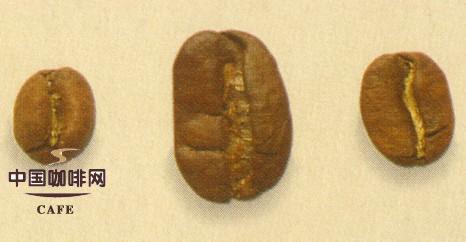Introduction of Gene Mutants of Fine Coffee beans

From left to right: Kenya Round Bean, Elephant Bean, Kenya AA
Bourbon Pointu: Discovered in Bourbon Island in 1810, the bean body has changed from round to pointed, with only half the caffeine content; but the quantity is small and weak, and it is extremely precious (mostly cultivated in the laboratory).
Maragogype (or Elephant Bean): The best-known variety of tibeka bean, first discovered in 1870 in the Maragogype bean-growing region of the northeastern Brazilian state of Bahia, the bean is at least three times larger than the average Arabica, hence the name. The flavor of elephant bean is bad at low altitude, but it is better at high altitude, with mild sour taste and sweet fragrance.
Geisha: A derivative of the Tibika family, Geisha was exported from the Geisha Mountains in southern Ethiopia in 1931, and after many countries became unknown, it was transplanted to Panama in the 1960s, and it began to win frequently in cup competitions in 2005.
Kenya "SL28" and "SL34": French and British missionaries and researchers in the early twentieth century in Kenya screening, breeding out of Bourbon lineages, a century has been adapted to Kenya's high concentration of phosphoric acid soil, breeding Kenya's characteristics of sour spirit; top Kenyan coffee are from these two varieties, but transplanted elsewhere is tasteless.
Bourbon Amarello (Yellow Bourbon): A variety of Bourbon endemic to the Brazilian state of Sao Paulo, whose coffee fruits do not turn red when ripe and are orange-yellow. Other local bourbon derivatives were later found to have yellowed skins.
Caturra: A single genetic variant of bourbon discovered in Brazil in the 1950s. Long energy and disease resistance are better than bourbon, and no shade trees are needed; flavor is equal to or slightly worse than bourbon.
Pacas: Bourbon variety found in El Salvador, 1935 El Salvador coffee farmers Pacas transplanted the name Bourbon, to 1956 found that the results are higher than other coffee trees of the same kind, please identify the genetic mutation after identification.
Villa Sarchi: Bourbon variety first discovered in Costa Rica in the 1960s, often appearing in cup test excellence lists in recent years.
Important Notice :
前街咖啡 FrontStreet Coffee has moved to new addredd:
FrontStreet Coffee Address: 315,Donghua East Road,GuangZhou
Tel:020 38364473
- Prev

Indonesia's top coffee beans Celebes Tongkonan Guobao beans
Celebes Tongkonan national treasure beans are the top coffee beans produced by Toraja on the island of Sulawesi, Indonesia. The reason why they are rare is that the annual output is less than 1000 barrels (1.5kg per barrel of raw beans). Most of the output is monopolized by European traders. It is used by the Indonesian royal family and EU officials as exclusive top beans for gifts. There is little circulation on the market, and a batch of them flowed into Taiwan in 2009.
- Next

Peruvian Coffee, a rising star in the boutique coffee industry
As a rising star in the coffee industry, Peruvian coffee is gradually opening up its popularity and entering the international market. Peruvian coffee has always been used as one of the stable and mellow mixed beans of comprehensive coffee. Peruvian coffee has a mellow taste and the right acidity, and this lukewarm coffee attitude has made more and more people like it. Peru is located in western South America, with a coastline of 2254 kilometers. Andes
Related
- Guji coffee producing area of Guji, Ethiopia: Humbela, Shakiso, Wulaga
- What is the most expensive variety of Qiloso in BOP multi-variety group?
- How to store the coffee beans bought home?
- Why are Yemeni coffee beans so rare now?
- Ethiopian Sidamo all Red Fruit Sun Sun Santa Vini Coffee beans
- SOE is mostly sour? What does it mean? Is it a single bean? what's the difference between it and Italian blending?
- Is Italian coffee beans suitable for making hand-brewed coffee?
- How to choose coffee beans when making cold coffee? What kind of coffee beans are suitable for making cold coffee?
- Just entered the pit to make coffee, what kind of coffee beans should be chosen?
- Can only Japan buy real Blue Mountain Coffee? What are authentic Jamaican Blue Mountain coffee beans?

